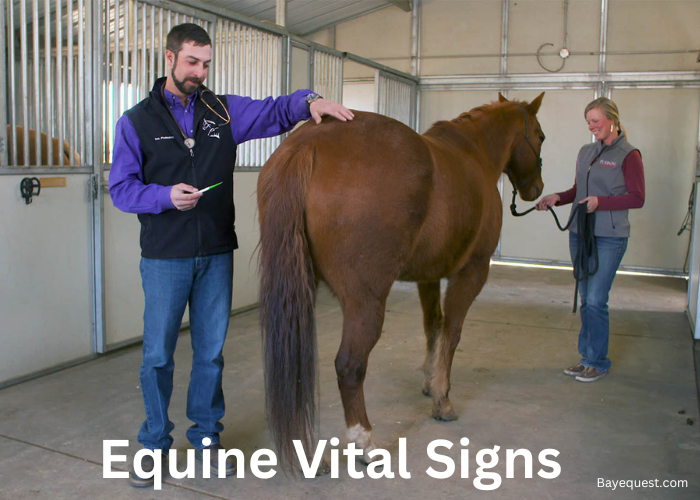A horse can’t tell you it’s sick, but its body will. You just need to know how to read the signs.
From a fever that sneaks in overnight to a pulse that races after rest, small changes can mean big trouble. And if you have a foal, the stakes are even higher.
Knowing what’s normal, and what’s not, can help you act fast and save your horse’s life. This isn’t guesswork.
It’s practical, barn-tested knowledge every horse owner should have. Let’s break down the equine vital signs that keep your horse healthy, safe, and sound.
What Are Equine Vital Signs?
Equine vital signs are the basic health measurements that tell you how your horse is doing.
They include temperature, pulse, respiration, mucous membrane color, capillary refill time, gut sounds, and hydration. These signs help you spot illness, stress, or injury, often before it becomes serious.
They act like a dashboard for your horse’s health. If something’s off, you’ll see it in the numbers. And just like people, horses have “normal” ranges that can vary slightly by age.
Knowing these baselines is the first step in keeping your horse safe and catching problems early.
Key Equine Vital Signs
If your horse seems “off,” the vital signs are the first place to look. These signs give you a clear picture of what’s happening inside, before problems get worse.
In this section, we’ll walk you through each key sign. You’ll learn what’s normal, how to check it, and when to worry.
Let’s break them down one by one.
Temperature
A horse’s temperature shows what’s going on inside the body. The normal range for an adult is 99–101°F (37.2–38.3°C). For a newborn foal, it’s a bit higher, 99.5–102.1°F (37.5–38.9°C).
To take a horse’s temperature, you’ll need a digital rectal thermometer, lubricant (like petroleum jelly), gloves, and a watch or timer.
Always approach calmly and stand to the side of the horse. Gently insert the thermometer into the rectum and wait for the beep. This usually takes 30 to 60 seconds.
Use a thermometer made for livestock or horses. Some come with a string or clip to avoid losing it inside.
Write down the reading in a health log. Include the date, time, and conditions (e.g., after work or at rest). This helps you spot trends or catch early signs of illness.
If the temperature is too high, your horse may have an infection, inflammation, or heat stress.
Too low could mean shock or cold exposure. Always compare with your horse’s normal range, not just textbook values.
Heart rate (Pulse)
A horse’s pulse tells you how hard its heart is working. For adults, the normal rate is 28–44 beats per minute. For newborn foals, the heart rate is much faster, typically 80–100 beats per minute.
To check it, you’ll need a watch with a second hand or a timer. You can feel the pulse in several spots:
- Under the jaw (facial artery)
- Behind the fetlock (digital artery)
- Under the tail (coccygeal artery)
Use your fingers, not your thumb, and count the beats for 15 seconds, then multiply by four. That gives you the beats per minute.
Always check the pulse while the horse is calm and at rest. Excitement or exercise will raise the number.
Record the rate in your logbook with the time and any notes about behavior or stress.
A high pulse could mean pain, fever, stress, dehydration, or illness. A low or weak pulse may show poor circulation or shock.
In foals, a very fast heart rate might be the first sign of trouble. Learn your horse’s normal pulse so you can spot danger early.
Respiratory rate
A horse’s breathing rate shows how well it’s taking in oxygen. The normal rate for adults is 10–24 breaths per minute. For newborn foals, it’s 20–40 breaths per minute.
To check it, stand quietly and watch the horse’s flank or nostrils. Each rise and fall counts as one breath. Use a watch or timer and count for 15 seconds, then multiply by four.
Make sure the horse is calm. Don’t take the rate right after exercise or stress. Also, avoid windy or dusty conditions that may cause faster breathing.
Write down the number along with the time, environment, and what the horse was doing just before. This helps track patterns over time.
Fast breathing can be a sign of pain, fever, respiratory illness, or heat stress.
Shallow, labored, or noisy breathing is also a red flag. In foals, even a small change in breathing can signal trouble.
Always check breathing along with other vital signs. One change may not mean much, but when paired with a fast pulse or high temperature, it’s time to call the vet.
Mucous membrane
A horse’s mucous membranes, mainly the gums, can reveal a lot about blood flow, hydration, and oxygen levels. Healthy gums should be moist and light pink in color.
To check, gently lift the upper lip and look at the gums above the teeth. They should feel slick, not dry or sticky.
- Color is key:
- Light pink = normal
- Pale or white = shock or blood loss
- Dark red or purple = heat stroke, poisoning, or severe illness
- Yellow = liver trouble
Next, press your finger gently into the gum. The spot will turn white. Count how long it takes for color to return.
This is called Capillary Refill Time (CRT). Normal CRT is two seconds or less.
Write down what you see in your health log. Note the gum color, moisture level, and CRT.
Dry or discolored gums often indicate a serious issue. Always check mucous membranes when your horse seems off, especially if you see other signs like fast breathing or a high pulse.
Capillary refill time
Capillary refill time tells you how well blood is flowing through your horse’s body. It’s a quick, easy check you can do using the gums.
To test CRT, gently lift the horse’s upper lip and press your finger against the gum. The spot will turn white.
Count how long it takes for the pink color to return. Normal refill time is two seconds or less.
If it takes longer than two seconds, your horse could be dehydrated, in shock, or having circulation problems. A refill time over three seconds is an emergency.
Always check CRT when your horse looks sick, tired, or stressed. It’s even more important if you also see pale, dark, or dry gums.
Record the time in your logbook and compare it to previous checks. When paired with temperature, pulse, and respiration, CRT helps you catch problems early, before they get serious.
Gut Sounds (Borborygmi)
Gut sounds are the noises your horse’s digestive system makes as it moves food and gas. These sounds are normal and healthy. In fact, no sound at all is a red flag.
Use a stethoscope or place your ear against the horse’s flank, just behind the ribs. Listen on both sides, upper and lower.
Normal sounds include:
- Gurgling
- Gas-like growls
- Tinkling (fluid moving)
- Occasional loud “roars”
Hearing frequent, active sounds is good. Quiet or no sounds could mean a blockage or colic. However, too many loud, rapid sounds may also point to irritation or diarrhea.
Check gut sounds when your horse is healthy to know what’s normal. Record what you hear: active, quiet, or silent, and on which side.
If the gut goes quiet, don’t wait. Combine this check with other vital signs, such as pulse and temperature.
A silent gut paired with pain or sweating is an emergency. Acting fast can save your horse’s life.
Hydration Status
A well-hydrated horse is a healthy horse. Dehydration can lead to serious problems, especially in hot weather or during illness.
The easiest way to check hydration is the skin pinch test. Gently pinch the skin on the neck or shoulder.
Then let go. The skin should snap back in one to two seconds. If it stays up or moves slowly, your horse may be dehydrated.
Also, check the gums. They should be moist, not dry or sticky. Dry gums are another sign your horse needs water fast.
Make sure your horse always has clean, fresh water, especially after exercise, travel, or hot days. Foals, seniors, and sick horses dehydrate faster, so check them more often.
Write down your findings in a log. If the skin is slow to rebound or the gums are dry, take action. Offer water, electrolytes, or call the vet if it doesn’t improve.
Hydration affects everything, pulse, gut sounds, and overall energy. Don’t wait until your horse stops drinking.
A quick skin pinch could catch a problem before it becomes a crisis.
Equine Vital Signs Table Summary
| Vital Sign | Adult Horse | Newborn Foal |
| Temperature | 99–101°F (37.2–38.3°C) | 99.5–102.1°F (37.5–38.9°C) |
| Pulse (Heart Rate) | 28–44 beats per minute | 80–100 beats per minute |
| Respiration Rate | 10–24 breaths per minute | 20–40 breaths per minute |
| Mucous Membranes | Moist, healthy pink | Same as adult |
| Capillary Refill Time | Two seconds or less | Same as adult |
| Gut Sounds | Gurgling, gas growls, tinkling, occasional roars | Similar sounds, quieter in foals |
| Hydration Status | Skin snaps back in 1–2 sec | Same method; check more often |
Common Vital Sign Mistakes
Even experienced horse owners can make simple mistakes when checking vital signs. These errors can lead to missed warning signs or false alarms.
Here are the most common ones to avoid:
Not knowing your horse’s normal. Every horse is different. What’s “normal” in one may be high or low in another. Always establish a baseline when your horse is healthy.
Checking after exercise or stress. Vital signs rise naturally after work or excitement. Always take readings when the horse is calm and at rest, unless assessing recovery.
Using the wrong tools. Household thermometers, stiff stethoscopes, or unreliable timers can give inaccurate results. Use equine-specific tools when possible.
Miscounting pulse or respiration. Counting for too short or guessing the rhythm can lead to wrong readings. Use a watch or timer and focus.
Ignoring gum color. Don’t just check temperature and pulse. Pale, blue, or dry gums often show trouble before anything else.
Forgetting both sides for gut sounds. Listening on only one side can give a false impression. Always check both flanks.
Not recording the results. Memory fades. Write everything down to spot changes over time and help your vet.

How to Check Vital Signs On Your Horse: Conclusion
Knowing your horse’s vital signs can save its life. A small change in temperature, pulse, or breathing can be the first sign of trouble.
Don’t wait for obvious symptoms. Check your horse regularly, even when it seems healthy.
Practice often so you feel confident in an emergency. Keep a log of each check, this makes patterns easier to spot.
Always trust your gut. If something feels off, it probably is. And when in doubt, call your vet.
A few simple checks can keep your horse safe, healthy, and happy for years to come.



 Click To Subscribe
Click To Subscribe





